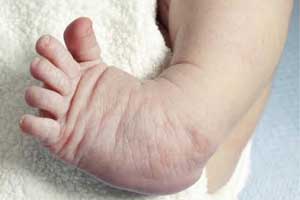- Home
- Editorial
- News
- Practice Guidelines
- Anesthesiology Guidelines
- Cancer Guidelines
- Cardiac Sciences Guidelines
- Critical Care Guidelines
- Dentistry Guidelines
- Dermatology Guidelines
- Diabetes and Endo Guidelines
- Diagnostics Guidelines
- ENT Guidelines
- Featured Practice Guidelines
- Gastroenterology Guidelines
- Geriatrics Guidelines
- Medicine Guidelines
- Nephrology Guidelines
- Neurosciences Guidelines
- Obs and Gynae Guidelines
- Ophthalmology Guidelines
- Orthopaedics Guidelines
- Paediatrics Guidelines
- Psychiatry Guidelines
- Pulmonology Guidelines
- Radiology Guidelines
- Surgery Guidelines
- Urology Guidelines
Doctors at Kasturba Medical College Discover Rare Bone Disease

A new study published in Human Mutation has reported the discovery of a rare disease affecting bone growth in children. The rsearchers at Kasturba Medical College revealed that the condition decreases the height of the individuals by abnormal development of bones.
The disease named Spondyloepimetaphyseal dysplasias (SEMD) is a group of genetically heterogeneous skeletal disorders characterized by abnormal vertebral bodies and epimetaphyseal abnormalities.
Dr. Girisha KM, the lead author of the study said, “Two patients from two different families were referred by child specialists when they noticed that the children were gaining height slowly as compared to other children of similar age.”
The clinical genetics team of experts at Manipal comprising Dr. Girish Katta and Dr. Anju Shukla, initially could not identify any known genetic condition. Hence, they started to look for yet unidentified cause of this condition. “The team used a state of art technique called exome sequencing that analyzes all the genes in an individual,” Dr. Girish said.
The clinical team was ably assisted by Neethukrishna Kausthubham as a bioinformatics expert and Dr. Srilakshmi Bhavani at Manipal looking into the mechanisms of the disease and correlating with the children’s condition. Once the team identified the gene, they were further assisted by the German team comprising Dr. Kerstin Kutsche and Dr. Leonie Von Elsner.
Further experiments were conducted on cell lines and mechanism of disease was elucidated. The overall work had inputs from Dr. Geert Mortier from Antwerp University in Belgium. The research spanned over three years.
Vice-Chancellor, Manipal Academy of Higher Education, Dr. H Vinod Bhat remarked; “This work illustrates the University’s commitment to foster collaborations with international universities to take MAHE to the global level in research.”
Dr. Pragna Rao, Dean KMC, Manipal said that the German and Belgian partners are visiting professors of KMC, Manipal. She added, “The experiments also suggest that this condition is potentially amenable to treatment.” Pro Vice-Chancellor Dr. Poornima Baliga congratulated the genetics team, which has already contributed to the discovery of nearly 15 new disorders from MAHE.
The radiographs of the patients show the abnormal vertebrae instead of normal rectangular shape and parts of the long bones (epiphyses) of the leg are larger when compared to normal bone.
"Our data demonstrated that the bi‐allelic hypomorphic PISD variant p. (Cys266Tyr) is associated with a novel SEMD form, which may be treatable with ethanolamine administration, "write the authors.

Disclaimer: This site is primarily intended for healthcare professionals. Any content/information on this website does not replace the advice of medical and/or health professionals and should not be construed as medical/diagnostic advice/endorsement or prescription. Use of this site is subject to our terms of use, privacy policy, advertisement policy. © 2020 Minerva Medical Treatment Pvt Ltd